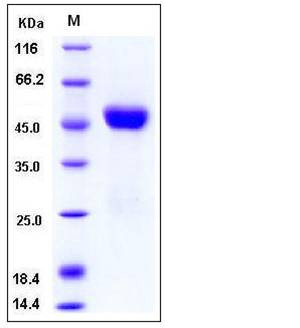Human CNTFR / CNTFR-alpha Protein (His Tag)
CNTFR, MGC1774
- 100ug (NPP2035) Please inquiry
| Catalog Number | P11012-H08B |
|---|---|
| Organism Species | Human |
| Host | Baculovirus-Insect Cells |
| Synonyms | CNTFR, MGC1774 |
| Molecular Weight | The recombinant human CNTFR consists of 335 amino acids and predicts a molecular mass of 36 kDa. The apparent molecular mass of rhCNTFR is approximately 45-48 kDa in SDS-PAGE under reducing conditions. |
| predicted N | Gln 23 |
| SDS-PAGE |  |
| Purity | > 98 % as determined by SDS-PAGE |
| Protein Construction | The amino acids sequence corresponding to (Met 1-Pro 346) of human CNTFR (NP_001833.1) was fused with a polyhistidine tag at the C-terminus. |
| Bio-activity | Measured by its binding ability in a functional ELISA . Immobilized human CTNFR at 10 μg/ml (100 μl/well) can bind biotinylated human CNTF with a linear ranger of 1.28-160 ng/ml . |
| Research Area | Signaling |Signal Transduction |Jak/STAT Signaling |Receptors in the Jak/STAT Pathway |
| Formulation | Lyophilized from sterile 50mM Tris, 100mM NaCl, pH 8.0 1. Normally 5 % - 8 % trehalose, mannitol and 0.01% Tween80 are added as protectants before lyophilization. Specific concentrations are included in the hardcopy of COA. |
| Background | Ciliary neurotrophic factor(CNTF) is a member of the cytokine family. It is a polypeptide hormone that have functions in promoting neurotransmitter synthesis and neurite outgrowth in certain neuronal populations. It's actions appear to be restricted to the nervous system. Ciliary neurotrophic factor(CNTF) has biological effects through the activation of a multi-subunit receptor complex, consisting of an extracelluar CNTF binding subunit(CNTFα) and two transmembrane signal transduction proteins: glycoprotein gp130 and LIF receptor. CNTF is considered as a potent survival factor of neurons and oligodendrocytes and may be relevant in reducing tissue destruction during inflammatory attacks. CNTF is also a survival factor for neurons of the peripheral sensory sympathetic, and ciliary ganglia. It has been reported that CNTF could be an agent that has therapeutic potential and possibly induces differentiation of large multipolar ganglionic phenotype in a subset of progenitors. |
| Reference |
